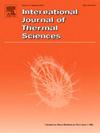Flow and heat transfer characteristics of liquid metal nanofluid in microchannel
IF 4.9
2区 工程技术
Q1 ENGINEERING, MECHANICAL
International Journal of Thermal Sciences
Pub Date : 2025-02-20
DOI:10.1016/j.ijthermalsci.2025.109787
引用次数: 0
Abstract
With the development of miniaturization and integration, electronic equipment needs to address efficient thermal management under high heat flow. Microchannel has broad application prospects in microelectronic device cooling. Further improving the heat transfer performance of heat sink and reducing pump power consumption has been an enduring topic. In this study, the liquid metal nanofluid (LMNF) microchannel cooling technology is proposed. The influence mechanism of LMNF parameter and microchannel structure on flow and heat transfer performance are studied through the simulations and experiments. The working fluid consists of Ga67In20.5Sn12.5 and copper nanoparticle (NP). Comprehensive performance of rectangular and wavy microchannel is analyzed in comparison. The results indicate that LMNF shows excellent heat transfer performance. The volume fraction of NP is the key parameter affecting heat transfer performance. Combined with the economic analysis, adding 1 ∼ 5 vol% NPs into the LM is more preferable. Moreover, the Raccoon structure with 0.05 mm amplitude performs superior heat transfer performance when the wavelength is set as 2.5 mm or 5 mm. In this study, the preferred parameters of working fluid and microchannel geometry are proposed, meanwhile the heat transfer correlation is fitted, which provides a theoretical guidance for optimizing micro heat sink.
求助全文
约1分钟内获得全文
求助全文
来源期刊

International Journal of Thermal Sciences
工程技术-工程:机械
CiteScore
8.10
自引率
11.10%
发文量
531
审稿时长
55 days
期刊介绍:
The International Journal of Thermal Sciences is a journal devoted to the publication of fundamental studies on the physics of transfer processes in general, with an emphasis on thermal aspects and also applied research on various processes, energy systems and the environment. Articles are published in English and French, and are subject to peer review.
The fundamental subjects considered within the scope of the journal are:
* Heat and relevant mass transfer at all scales (nano, micro and macro) and in all types of material (heterogeneous, composites, biological,...) and fluid flow
* Forced, natural or mixed convection in reactive or non-reactive media
* Single or multi–phase fluid flow with or without phase change
* Near–and far–field radiative heat transfer
* Combined modes of heat transfer in complex systems (for example, plasmas, biological, geological,...)
* Multiscale modelling
The applied research topics include:
* Heat exchangers, heat pipes, cooling processes
* Transport phenomena taking place in industrial processes (chemical, food and agricultural, metallurgical, space and aeronautical, automobile industries)
* Nano–and micro–technology for energy, space, biosystems and devices
* Heat transport analysis in advanced systems
* Impact of energy–related processes on environment, and emerging energy systems
The study of thermophysical properties of materials and fluids, thermal measurement techniques, inverse methods, and the developments of experimental methods are within the scope of the International Journal of Thermal Sciences which also covers the modelling, and numerical methods applied to thermal transfer.
 求助内容:
求助内容: 应助结果提醒方式:
应助结果提醒方式:


